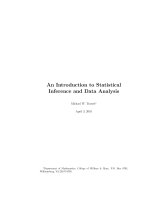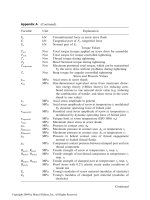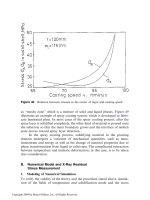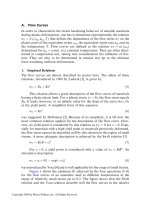an introduction to network modeling and simulation for the practicing engineer
Bạn đang xem bản rút gọn của tài liệu. Xem và tải ngay bản đầy đủ của tài liệu tại đây (1.73 MB, 217 trang )
AN INTRODUCTION TO
NETWORK MODELING
AND SIMULATION FOR
THE PRACTICING
ENGINEER
IEEE Press
445 Hoes Lane
Piscataway, NJ 08854
IEEE Press Editorial Board
Lajos Hanzo, Editor in Chief
R. Abhari M. El - Hawary O. P. Malik
J. Anderson B - M. Haemmerli S. Nahavandi
G. W. Arnold M. Lanzerotti T. Samad
F. Canavero D. Jacobson G. Zobrist
Kenneth Moore, Director of IEEE Book and Information Services (BIS)
Technical Reviewers
Nim K. Cheung
Richard Lau
A volume in the IEEE Communications Society series:
The ComSoc Guides to Communications Technologies
Nim K. Cheung, Series Editor
Thomas Banwell, Associate Editor
Richard Lau, Associate Editor
Next Generation Optical Transport: SDH/SONET/OTN
Huub van Helvoort
Managing Telecommunications Projects
Celia Desmond
WiMAX Technology and Network Evolution
Edited by Kamran Etemad, Ming - Yee Lai
An Introduction to Network Modeling and Simulation for the Practicing Engineer
Jack Burbank, William Kasch, Jon Ward
AN INTRODUCTION TO
NETWORK MODELING
AND SIMULATION FOR
THE PRACTICING
ENGINEER
Jack Burbank
William Kasch
Jon Ward
A JOHN WILEY & SONS, INC., PUBLICATION
IEEE PRESS
The ComSoc Guides to Communications Technologies
Nim K. Cheung, Series Editor
Thomas Banwell, Associate Series Editor
Richard Lau, Associate Series Editor
Copyright © 2011 by Institute of Electrical and Electronics Engineers. All rights reserved.
Published by John Wiley & Sons, Inc., Hoboken, New Jersey.
Published simultaneously in Canada.
No part of this publication may be reproduced, stored in a retrieval system, or transmitted in
any form or by any means, electronic, mechanical, photocopying, recording, scanning, or
otherwise, except as permitted under Section 107 or 108 of the 1976 United States Copyright
Act, without either the prior written permission of the Publisher, or authorization through
payment of the appropriate per-copy fee to the Copyright Clearance Center, Inc., 222
Rosewood Drive, Danvers, MA 01923, (978) 750-8400, fax (978) 750-4470, or on the web at
www.copyright.com. Requests to the Publisher for permission should be addressed to the
Permissions Department, John Wiley & Sons, Inc., 111 River Street, Hoboken, NJ 07030, (201)
748-6011, fax (201) 748-6008, or online at />Limit of Liability/Disclaimer of Warranty: While the publisher and author have used their best
efforts in preparing this book, they make no representations or warranties with respect to the
accuracy or completeness of the contents of this book and specifi cally disclaim any implied
warranties of merchantability or fi tness for a particular purpose. No warranty may be created
or extended by sales representatives or written sales materials. The advice and strategies
contained herein may not be suitable for your situation. You should consult with a professional
where appropriate. Neither the publisher nor author shall be liable for any loss of profi t or any
other commercial damages, including but not limited to special, incidental, consequential, or
other damages.
For general information on our other products and services or for technical support, please
contact our Customer Care Department within the United States at (800) 762-2974, outside the
United States at (317) 572-3993 or fax (317) 572-4002.
Wiley also publishes its books in a variety of electronic formats. Some content that appears in
print may not be available in electronic formats. For more information about Wiley products,
visit our web site at www.wiley.com.
Library of Congress Cataloging-in-Publication Data is available.
ISBN: 978-0-470-46726-8
oBook ISBN: 978-1-118-06365-1
ePDF ISBN: 978-1-118-06363-7
ePub ISBN: 978-1-118-06364-4
Printed in Singapore.
10 9 8 7 6 5 4 3 2 1
CONTENTS
Preface vii
Acknowledgments ix
About the Authors xi
1. Introduction 1
1.1 Advantages and Disadvantages of Modeling and Simulation 6
1.2 Comparison of “Homebrew” Models and Simulation Tools 8
1.3 Common Pitfalls of Modeling and Simulation and
Rules of Thumb 9
1.4 An Overview of Common M&S Tools 16
1.5 An Overview of the Rest of This Book 18
2. Modeling and Simulation for RF Propagation 20
2.1 The Fading Channel 22
2.2 The ITU M.1225 Multipath Fading Profi le for
Mobile WiMAX 38
2.3 Practical Fading Model Implementations—
WiMAX Example 42
2.4 RF Propagation Simulators 45
2.5 Propagation and Fading Simulations—Lessons Learned 48
3. Physical Layer Modeling and Simulation 51
3.1 Incorporating Interference into a Model 52
3.2 The Importance of a Preamble 59
3.3 Practical Wireless PHY Model Implementations 62
3.4 Wireless Network Simulation Lessons Learned and
Common Pitfalls—PHY Layer 69
v
vi CONTENTS
4. Medium Access Control Modeling and Simulation 72
4.1 Modeling and Simulation of Wired MACs 73
4.2 Wireless Network MAC Simulation 78
4.3 Practical MAC Model Implementations 90
4.4 Network Simulation Lessons Learned and Common
Pitfalls—MAC Layer 92
5. Modeling and Simulation for Higher Layer Protocols 97
5.1 Network Layer 97
5.2 Transport and Application Layers 102
5.3 Example of Higher Layer Modeling: Transport Layer
Performance Analysis 105
5.4 Example of Higher Layer Modeling: Detailed Network
Layer Modeling 109
6. Hardware-in-the-Loop Simulations 114
6.1 Advantages and Disadvantages of HITL Approaches 118
6.2 Network M&S HITL Approaches 120
6.3 HITL Examples 126
6.4 Common Pitfalls for HITL Approaches 139
6.5 Network-Layer HITL-Ready Network Simulation Platforms 139
6.6 HITL Conclusion 142
7. Complete Network Modeling and Simulation 143
7.1 Complete Network M&S Platforms 145
7.2 IEEE HLA (1516) 145
7.3 Complete Network Simulation Examples 172
8. Other Vital Aspects of Successful Network Modeling
and Simulation 180
8.1 Verifi cation and Validation 180
8.2 Data Visualization and Interpretation 185
9. Network Modeling and Simulation: Summary 186
References 188
Index 196
vii
PREFACE
This book provides an overview of the current state - of - the - art in modeling
and simulation (M & S) tools and discusses many of the pitfalls most commonly
encountered by network engineers. A bottom - up approach is taken in describ-
ing network M & S, following the Transport Control Protocol / Internet Protocol
(TCP/IP) modifi ed Open System Interconnect (OSI) stack model . While
applicable to network M & S in general, there is particular emphasis placed on
wireless network M & S. This book fi rst decomposes the wireless network M & S
problem into a set of smaller scopes: 1) radio frequency (RF) propagation
M & S (Chapter 2 ), 2) physical layer (PHY) M & S (Chapter 3 ), 3) Medium
Access Control (MAC) layer (Chapter 4 ), and 4) higher layer M & S (Chapter
5 ). After considering each of these smaller scopes somewhat independently,
the book then revisits the overall problem of how to conduct M & S of a wire-
less networking system in its entirety.
No specifi c assumptions are made on the type of network being modeled
in any particular layer of the protocol stack. Instead, the building blocks are
presented to address the common challenges of modeling any wireless network.
The reader is also directed to resources that provide more detail on specifi c
topics. Resources are chosen from generic studies of wireless networks and
from the Mobile Ad Hoc Network (MANET) and ad hoc sensor network
communities. This book is written with particular emphasis placed on specifi c
topics at the different layers of the protocol stack, with the intention of bridg-
ing gaps between the computer science and electrical engineering communi-
ties. Historically, the higher layers of the protocol stack are often considered
research subjects for computer scientists and the lower layers for electrical
engineers. In fact, accurate simulations must capture the cross - layer interac-
tions and higher layer simulations must consider the impacts of the lower layer
conditions on results. The authors hope that this book will educate the reader
in simulation topics that may have not otherwise been considered and will
ultimately lead to improved simulation results in the wireless networking
research community.
This book can improve the reader ’ s background knowledge on the key
components of successful wireless network simulations. But, ultimately, the
reader must learn to validate his or her own simulation since they alone will
know all specifi c details and assumptions that lead to a specifi c result. In
general, the output of a simulation should not be a surprise to the designer,
and, it if is, suffi cient research into the underlying protocol must be conducted
viii PREFACE
to explain any unanticipated results. Because there are so many variables
present in a model and therefore so many potential locations where errors are
introduced, a model output should not be taken as ground truth without other
methods of verifi cation. Results may be compared with results from other
researchers, but as some papers [1 – 4] note, results between two equivalent
scenarios simulated on two different simulators may not match. In this case,
the designer must not only validate whether or not his or her simulation is
correct, but also what led to results not matching the other simulation. Results
should not be published until the simulation designer has confi dence in the
model, the results have been validated to the best of the designer ’ s ability, and,
once published, should contain all model parameters, assumptions, and simula-
tion source code.
In this book only a select set of simulators have been considered as the
most popular commonly used by academic and industrial researchers. These
include OPNET, NS - 2, GloMoSim, and QualNET. There is no single, all -
purpose simulator that is best for all scenarios. Additionally, budget con-
straints often force researchers to choose open - source simulators over
commercial solutions. Custom simulation solutions (i.e., homebrew simula-
tions) are certainly too numerous to be considered. Note that the risk of citing
specifi c simulators is that these tools are continually evolving. This means that
statements about a given product ’ s current capabilities may no longer be
valid, as subsequent releases enhance a tool ’ s capabilities. Care has been
taken by the authors to focus on principles and practices that assist the simu-
lation designer in improving wireless network simulations while remaining
independent of a particular simulator, and hence topics and results are not as
limited to an expiration date.
J
ACK B URBANK
W ILLIAM K ASCH
J ON W ARD
To view color versions of the fi gures in this book, please visit
.
ix
ACKNOWLEDGMENTS
We would like to acknowledge the numerous individuals who have helped
make this book a reality. First and foremost, we would like to acknowledge
Brian Haberman and Julia Andrusenko for their assistance in writing this
book, contributing their expertise and understanding of network simulation
tools and radio frequency propagation tools, respectively.
We would like to thank Robert Nichols for his long - time support of our
activities in this fi eld.
We would like thank all of our friends and family for their patience and
support during the writing of this book.
xi
ABOUT THE AUTHORS
Jack L. Burbank ( ) received his B.S. and M.S. degrees
in electrical engineering from North Carolina State University (NCSU) in
1994 and 1998, respectively. As part of the Communications and Network
Technologies Group of The Johns Hopkins University Applied Physics
Laboratory (JHU/APL), he works with a team of engineers focused on assess-
ing and improving the performance of wireless networking technologies
through test, evaluation, and technical innovation. His primary expertise is in
the areas of wireless networking and modeling and simulation, focusing on the
application and evaluation of wireless networking technologies in the military
context. He has published numerous technical papers and book chapters on
topics of wireless networking, and regularly acts as a technical reviewer for
journals and magazines. He teaches courses on the topics of networking and
wireless networking in the Johns Hopkins University Part Time Engineering
Program, and is a member of the IEEE and the ASEE.
William T.M. Kasch ( ) received a B.S. in electrical
engineering from the Florida Institute of Technology in 2000 and an M.S. in
electrical and computer engineering from Johns Hopkins University in 2003.
His interests include various aspects of wireless networking technology, includ-
ing MANETs, IEEE 802 standards, and cellular. He participates actively in
both the IEEE 802 standards organization and the Internet Engineering Task
Force (IETF).
Jon R. Ward, PE ( ) graduated from NCSU in 2005 with
an M.S. degree in electrical engineering. He works at JHU/APL on projects
focusing on wireless network design and interference testing of standards -
based wireless technologies such as IEEE 802.11, IEEE 802.15.4, and IEEE
802.16. He has experience in wireless network modeling and simulation (M & S)
and test and evaluation (T & E) of commercial wireless equipment. He is cur-
rently a student at the University of Maryland, Baltimore County (UMBC),
pursuing a Ph.D. degree in electrical engineering.
1
An Introduction to Network Modeling and Simulation for the Practicing Engineer, First Edition.
Jack Burbank, William Kasch, Jon Ward.
© 2011 Institute of Electrical and Electronics Engineers. Published 2011 by John Wiley & Sons, Inc.
CHAPTER 1
Introduction
Communications systems continue to evolve rapidly. Users continue to demand
more high - performance networking capabilities. Service providers respond to
this demand by rapid expansion of their network infrastructure. Network
researchers continue to develop revolutionary new communications tech-
niques and architectures to provide new capabilities commensurate with
evolving demands. Equipment vendors continue to release new devices with
ever - increasing capability and complexity. Technology developers rapidly
develop next - generation replacements to existing capabilities to keep up with
demand. These rapid developments in the network industry lead to a large,
complex landscape.
The network designer and developer wants (and needs) to satisfy the
demands of the users. This is diffi cult, as it is often complicated for the typical
network engineer to fully understand this rapidly evolving communications
landscape. This challenge is exacerbated by the nature of emerging technolo-
gies and techniques that are often extremely complex compared with their
legacy counterparts. This leaves the typical network engineer with more ques-
tions than answers. The network engineer tasked with maintaining an opera-
tional network might ask the following: What is the right approach to solving
my problem? Do I buy the latest device from company X that claims to solve
all my problems? Do I replace the underlying technology of my system with
the latest generation? How do I know whether a technology is mature enough
to survive the rigors of my application? How do I know how my already exist-
ing network system will respond if I add this device? The network engineer
researching next - generation networking techniques might ask: How do I know
how this new approach will interact with already - existing protocols? or How
do I build confi dence in the utility of this approach without producing and
deploying the technology? The network engineer developing a particular
product might ask: How do I ensure that this design will satisfy requirements
2 INTRODUCTION
before I go to production? or How can I assess the utility of a design choice
compared to its envisioned cost? This book aims to help answer these
questions.
There are many tools available to the network engineer that can assist in
answering these questions, including analysis, prototype implementation and
empirical testing, trial fi eld deployments, and modeling and simulation (M & S).
It should be stated now that no one tool is typically suffi cient in understanding
the performance of a network; unfortunately, there is no “ silver bullet ” answer
to all our questions. The complex nature of emerging systems also introduces
signifi cant complexity into the effective evaluation of these systems and how
these various tools can be employed. Evaluation is often conducted through
the coordinated usage of analysis, M & S, and trial deployments in closely moni-
tored environments. Due to the costs and complexities of deployments, analy-
sis and M & S are often used to determine the most sensitive performance areas
that are then the focus of trial deployments. This limits the scope of the trial
deployment to a realistic level while focusing on the important cases to
consider.
Because of the increasingly interconnected nature of communications
systems, and the resulting interdependencies of individual subsystems to
operate as a whole, it will often be the case that individual subsystems cannot
be tested in isolation. Rather, multiple systems must be evaluated in concert
to verify system - level performance requirements. This increases the required
scale of trial deployments and adds signifi cant complexity as now several dif-
ferent types of measurements will often be required in several different loca-
tions simultaneously. This increases the required support for a deployment in
terms of required resources, including personnel and measurement equipment,
further limiting the realistic amount of trial deployments. Thus, this will place
a premium on analysis and M & S to perform requirements verifi cation and to
form the basis of any performance evaluation. In many cases, M & S may
provide the only viable method for providing insight into the behavior of the
eventual system prior to full - scale deployment.
Once the importance of M & S is established, many additional questions
still arise: How does the network engineer properly employ M & S? What
are the most appropriate M & S tools to employ? While networking tech-
nologies continue to evolve rapidly, so too do M & S tools intended to
evaluate their performance. The M & S landscape is indeed a complicated
space with a multitude of tools with a variety of capabilities and pitfalls.
Furthermore, there is often a poor understanding of the proper role and
application of M & S and how it should fi t within the overall evaluation
strategy. There is even confusion surrounding the term M & S itself. Before
we continue, let us provide some basic defi nitions that will be used through-
out the book.
Modeling and simulation (M & S) are often combined as a single term.
However, a model is quite different than a simulation. This book defi nes these
two entities as:
INTRODUCTION 3
Model : A logical representation of a complex entity, system, phenomena, or
process. Within the context of communications and networking, a model
is often an analytical representation of some phenomena (e.g., a math-
ematical representation for the output of a system component) or a state
machine representation. This analytical representation can either be in
a closed form or an approximation obtained through assumptions.
Simulation : An imitation of a complex entity, system, phenomena, or process
meant to reproduce a behavior. Within the context of a communications
network, a simulation is most often computer software that to some
degree of accuracy functionally reproduces the behavior of the real
entity or process, often through the employment of one or more models
over time.
Emulation : An imitation of a real - world, complex entity or process meant
to perfectly reproduce a behavior or process. Emulation can be thought
of as perfect simulation of something such that it is equivalent to the
original entity.
To illustrate the difference between a model and a simulation, consider a
simple signal detection circuit. A simulation of this device would imperfectly
mimic the various actions of the detection circuit to determine a likely outcome
for a given input. A model of this same device would generally take the form
of a mathematical algorithm that would produce (either perfectly or imper-
fectly) an output for a given input.
Unfortunately, the terms model and simulation are often incorrectly used
interchangeably. Generally speaking, the term simulation has wider scope than
the term model, where a simulation is typically a compilation of models and
algorithms of smaller components of the larger overall entity or process. This
book generally uses the combined term M & S to generically refer to the
employment of models, simulations, and emulators to approximate the behav-
ior of an entity or process.
There are numerous types of computer models and simulations. A computer
model or simulation can generally be classifi ed according to several key
characteristics:
•
Stochastic vs. Deterministic: Deterministic models are those that have no
randomness. A given input will always produce the same output given the
same internal state. Deterministic models can be defi ned as a state
machine. Deterministic models are the most common type of computer
model. A stochastic model does not have a unique input - to - output
mapping and is generally not widely employed, as it leads to unpredict-
ability in execution. A simulation can be made to act in a pseudo - random
manner through the employment of random number generators to
represent random events. However, the particular models governing
the behavior of each component within the simulation are generally
deterministic.
4 INTRODUCTION
•
Steady - state vs. Dynamic: Steady - state models attempt to fi nd the
input - to - output relationship of a system or entity once that system is in
steady - state equilibrium. A dynamic simulation represents changes to
the system in response to changing inputs. Steady - state approaches
are often used to provide a simplifi ed model prior to dynamic simulation
development.
•
Continuous vs. Discrete: A discrete model considers only discrete moments
in time that correspond to signifi cant events that impact the output or
internal state of the system. This is also referred to as a discrete - event
(DE) model or DE simulation. This requires the simulation to maintain
a clock so that the current simulation time can be monitored. Jumps
between discrete points in time are instantaneous; nothing happens
between discrete points in time corresponding to interesting events.
Continuous simulations consider all points in time to the resolution of the
host ’ s hardware limitations (all computer simulations are discrete to some
extent because of the fact that it is running on a digital platform with a
fi nite speed clock). DE methods are the most commonly used for network
M & S.
•
Local or Distributed: A distributed simulation is such that multiple com-
puter platforms that are interconnected through a computer network
work together, interacting with one another, to conduct the simulation. A
local simulation resides on a single host platform. Historically, local simu-
lations have been the most common. But the increasing complexity of
simulations have increased the importance of distributed simulation
approaches.
In general, a simulation can be thought of as a piece of software residing on
a computer platform that implements a set of algorithms and routines and
takes a set of inputs to produce a set of outputs that represent the behavior
of the system of interest. This is depicted in Figure 1 - 1 .
The typical inputs that are important to consider when simulating a wireless
network are summarized in Table 1 - 1 . The typical outputs that are often of
interest are summarized in Table 1 - 2 .
FIGURE 1 - 1. A block diagram of a wireless communications system simulation.
SIMULATION SOFTWARE
- Algorithms
- Routines
Inputs Outputs
Bit Error Rate
Packet Error Rate
Message Success Rate
Signal Level
Noise Level
Waveform Type
Coding Method
Retransmission Scheme
Number of Nodes
Contention Method
INTRODUCTION 5
TABLE 1 - 1. Typical Inputs to a Wireless Network Simulation
Parameter Explanation
Signal power This will infl uence the received power level and
consequently the Bit Error Rate (BER) and
Packet Error Rate (PER) performance of the
wireless link.
Waveform type This will infl uence the BER and PER
performance of the wireless link in a given
channel.
Forward error control coding
(FEC) method
This will infl uence the BER and PER
performance of the wireless link in a given
channel.
Retransmission protocol This will affect the throughput and delay
performance of the wireless link.
Contention method This will infl uence BER, PER, throughput, and
delay performance of the wireless link in a
given channel.
Channel model This will determine the performance of a given
wireless link in terms of received power level,
BER, and PER.
Mobility model This will impact the performance of the MAC
layer protocol and of the higher layers
(e.g., IP routing).
Traffi c model This will impact the performance of the MAC
layer protocol and of the higher layers
(e.g., IP routing).
Network topology This will impact the performance of the MAC
layer protocol and of the higher layers
(e.g., IP routing).
TABLE 1 - 2. Typical Outputs from a Wireless Network Simulation
Parameter Explanation
BER The fundamental performance metric of a digital
communications link.
PER Often considered the most important performance
metric in a packet - switched network.
Throughput The data rate supportable by the wireless network.
Goodput The useful data rate supported by the wireless network
(i.e., data rate as available by the application).
Latency The end - to - end delay that an application or user will
experience across the wireless network.
6 INTRODUCTION
1.1 ADVANTAGES AND DISADVANTAGES OF
MODELING AND SIMULATION
As is the case with any tool, M & S has both advantages and disadvantages.
This section provides a tradeoff framework for the designer or developer to
consider when choosing to employ M & S. In the following section, M & S is
often compared with empirical testing. For the purposes of this book, empirical
testing refers to real - world testing of equipment (e.g., physical hardware
devices) deployed in a physical environment.
1.1.1 Breadth of Operational Scenario
First and foremost, M & S provides the ability to exercise a wide range of
operational scenarios. Empirical testing will exercise a much smaller portion
of the possible scenario space than will M & S. This includes the ability to evalu-
ate greatly increased network scale (e.g., number of network nodes), not easily
achieved in empirical activities, and more dynamic choice of environmental
conditions (e.g., wireless environment). Because of the ability to exercise a
wide variety of scenarios, M & S has a clear advantage in this aspect.
1.1.2 Cost
Generally, another advantage of M & S is reduced cost compared with empiri-
cal testing and trial deployments. Extensive empirical testing carries a high
cost, to the point where extensive empirical - only approaches are largely
impossible in the modern wireless networking landscape; however, this
advantage is dependent on the scope placed on the M & S development
effort.
1.1.3 Confi dence in Result
A less obvious advantage of M & S is the amount of precision and control that
can be exerted over the scenario in question. In the empirical scenario, mea-
surements are taken and then those measurements are analyzed and under-
stood for their ramifi cations. However, due to the uncontrolled nature of
empirical testing, there are often many variables that affect the measurement.
And often the number of uncertain variables is so great that it is impossible
to isolate the source of any behavior or to correlate a measurement to its
source (i.e., map the effect to the cause). This limits the scientifi c utility of such
measurements, and makes it diffi cult to associate a high degree of confi dence
to the measurement. The “ the data is what it is ” philosophy is rarely justifi ed
if the phenomena under observation are not understood. Note, this is much
more the case for over - the - air (OTA) empirical activities. Other empirical
activities are much more highly controllable (e.g., direct radiofrequency (RF)
chain testing).
ADVANTAGES AND DISADVANTAGES OF MODELING AND SIMULATION 7
The primary, and most obvious, disadvantage of M & S is that it is not real.
It is a representation of the system, rather than the system itself. There are
several assumptions that will be built into any M & S tool. Some of these
assumptions will be necessitated by real - world complexities that are not
easily represented. Others are necessitated by a lack of information available
about the system in question. This will naturally lead to inaccuracies.
Consequently, this leads to a decreased confi dence in results. This confi dence
decrease is manageable, however, through verifi cation and validation activi-
ties, often in conjunction with empirical activities to improve confi dence in
such models.
A higher degree of confi dence is almost always associated with empirical
methods, regardless of the methodology or practices employed during those
empirical activities. Unfortunately, this confi dence can be ill placed. The
common belief is that M & S - based methods are more subject to error because
software - based “ bugs ” could introduce unforeseen inaccuracies. And while
that is defi nitely true, the same applies to the empirical - based approach. Any
empirical measurement will have error associated with it (e.g., imperfections
in hardware employed to make a measurement, misconfi guration of test equip-
ment). Also, human interpretation must at some point be applied to under-
stand an empirical measurement. This human interpretation can be infl uenced
by assumptions, biases, and preconceived opinions.
Another issue is that of statistical signifi cance. Even if measurement error
has been minimized, there are several factors that can infl uence the signifi -
cance of that measurement. Take, for example, the measurement of an antenna
pattern, which is a key characteristic that will impact wireless network perfor-
mance. This antenna pattern will vary across antenna population due to manu-
facturing variation, differences in platform, and differences in age and
condition. Furthermore, the RF propagation environment characteristics will
be temporal in nature. Thus, a particular measurement is somewhat insignifi -
cant in the overall sense. In fact, to make empirical activities truly signifi cant
from a statistical standpoint is often cost prohibitive.
With all these factors considered, an empirical approach is still considered
to have an advantage, especially if issues such as measurement error and
uncertainty are built into empirical activities. However, the proper application
of verifi cation and validation practices can help minimize this difference.
1.1.4 Perception
Even if a model is highly accurate, and from a scientifi c perspective is highly
regarded, there is the issue of perception. Many individuals will still remain
skeptical of the results from a computer model. This is due to sociological and
psychological phenomena that are well beyond the scope or timeframe of any
particular M & S activity. Rather, this reality must be accepted and factored
into the overall evaluation approach. An empirical - based evaluation method
has the overwhelming advantage in this area. In fact, this advantage is so
8 INTRODUCTION
strong that some degree of empirical testing is likely required to give credibil-
ity to the fi ndings of the overall M & S activity.
1.1.5 The Need for Verifi cation and Validation
While not considered a disadvantage, certainly a burden associated with M & S
is the need to conduct verifi cation and validation (V & V) activities. Such activi-
ties are generally required to both verify the accuracy and consistency of
model output and validate output relative to other models, empirical tests, and
theory. While V & V activities are mandated by good software engineering
principles and must be adhered to, the formality of a V & V process can levy
signifi cant resource requirements on a project. This partially negates the cost
advantage of M & S over empirical testing.
In some sense, M & S is disadvantaged in this regard compared with other
tools available to the network engineer. As mentioned previously, there is
typically less scrutiny placed on empirical measurements and, consequently,
there is typically a greater “ burden of proof ” placed on an M & S developer as
compared with the empirical tester.
1.2 COMPARISON OF “ HOMEBREW ” MODELS
AND SIMULATION TOOLS
Custom simulations, or “ homebrew ” solutions, are those in which the imple-
menter does not rely on any existing tools but rather develops the simulation
in its entirety. The advantages of homebrew simulations include:
•
The implementer knows exactly what has been implemented.
•
Homebrew solutions can have signifi cant performance benefi ts.
The disadvantages of homebrew simulations include:
•
They can be costly to develop.
•
They can be diffi cult to upgrade.
•
There is a real risk of these custom simulations not being widely adopted,
even within your organization (resulting in perpetual “ homebrew ”
solutions).
Other than small - scale efforts that are supporting analysis, homebrew
approaches are generally discouraged. With the ever - increasing complexity of
wireless networking systems, the feasibility of a meaningful homebrew solu-
tion is dwindling. Even for cases where there are no existing implementations
of a particular networking technology and code development is inevitable, it
is recommended that this new custom simulation be developed within existing
COMMON PITFALLS OF MODELING AND SIMULATION AND RULES OF THUMB 9
tools/environments so that it can be integrated with and leverage existing
simulation libraries.
1.3 COMMON PITFALLS OF MODELING AND SIMULATION
AND RULES OF THUMB
There are many potential pitfalls that face those who embark on a network
simulation development effort. This section discusses some of those most com-
monly seen.
1.3.1 Model Only What You Understand
It can be said that the utility of a given model is only as good as the degree
to which it represents the actual system being modeled. Indeed, a system —
whether a wireless network or otherwise — can only be modeled once it is
suffi ciently understood. While this is a simple tenant, it is one that is certainly
not adhered to universally by M & S designers. One may ask why M & S design-
ers develop invalid models. There are many reasons, the fi rst of which is that
high - fi delity model development requires a signifi cant investment of time and
effort. This statement is not meant to offend developers or to imply careless-
ness on their part. The fact is that many designers are under time constraints
to deliver results. Consequently, a careful understanding of the underlying
system being modeled and rigorous validation of the model is not always an
option.
While understandable, this is at the same time unacceptable. It is highly
unlikely that a simulation developer can provide a meaningful result when
they did not understand the system they were intending to model. While the
timeline might have been met, the result was likely meaningless. Worse yet,
the result was likely wrong and might have adversely affected larger design or
business decisions. Model only what you understand! If you don ’ t have a fun-
damental understanding of a technology, there is no way you can effectively
model or simulate that technology. This step cannot be skipped in a successful
M & S effort. If this step cannot be completed, it is better to not proceed down
the path of M & S development.
1.3.2 Understand Your Model
It is quite common for the network engineer to utilize off - the - shelf tools, either
commercial or open source. This approach typically lends itself to a faster
M & S development cycle; however, it is imperative that the network engineer
has a full understanding of the tools being used. Most simulations are likely
to have errors — even commercial tools. New simulation implementations
almost always contain errors. Simulation implementations can make assump-
tions that may not accurately refl ect the exact performance metric of interest.
10 INTRODUCTION
If the simulation developer utilizes existing simulation implementations, it is
imperative to allocate the proper amount of time to closely examine that
implementation to fully understand what that code is doing and what it is not
doing. There is no better way to lose credibility than to not be able to answer
questions about one ’ s own results. Understand what you have modeled! There
are resources available to help with this, including technical support for com-
mercial tools, online newgroups and user forums for open source tools, and in
some cases the simulation designer can contact the author directly (e.g., a
contributed simulation to an open source project).
1.3.3 Make Your Results Independently Repeatable
Many academic papers such as [1 – 3] have discussed the lack of independent
repeatability in wireless network simulation results due to improper documen-
tation of the simulator being utilized, model assumptions, and inputs and
outputs. There are subtle parameters and assumptions embedded in simulators
such as NS - 2 and GloMoSim that certainly can impact all results. Often default
simulator parameters are chosen that may not capture the intended network
conditions for a given scenario [2] . Perhaps the larger problem is that simula-
tion results are often presented as ground truth and not as a relative ranking
of a new idea compared to existing ideas. That is, the literature survey compo-
nent must always be present in wireless network research and simulation
results should be compared to existing results to demonstrate advantages and
disadvantages of new ideas. Moreover, new simulation results must be com-
pared with results in existing literature using the same simulator, underlying
assumptions, and parameter conditions.
1.3.4 Carefully Defi ne M & S Requirements
This is an activity that is too often ignored or given superfi cial treatment. The
authors would argue that network engineers all too often rush into an M & S
effort without a clear idea of what they are hoping to accomplish. This is a
surefi re recipe for failure.
The fi rst step is to clearly understand the metrics of interest that would
be generated by a simulation. Is overall network throughput the metric
of interest? Is BER the metric of interest? End - to - end delay? Not all simula-
tion tools necessarily lend themselves to the same types of output metrics, so
it is important to defi ne these metrics so that tool selection is an informed
process.
The next step is to clearly defi ne the required performance of the simulation
to be developed. This book contends that there are four primary dimensions
of performance:
•
Cost : The overall investment in resources towards the development and
maintenance of the M & S activity. This includes not only original platform
COMMON PITFALLS OF MODELING AND SIMULATION AND RULES OF THUMB 11
costs, but also development time, upgrade and maintenance costs, and
troubleshooting.
•
Scalability : The total complexity of the system to be simulated. There are
two factors that must be considered: network size in terms of number of
nodes, and network traffi c model in terms of number of messages per unit
time. These two factors will drive the computational complexity of the
simulation and will ultimately be the limiting factors in the size of the
network that can be simulated. This is generally governed by software
complexity and hardware capability.
•
Execution Speed : For a given simulation scenario, how quickly can
that simulation complete and provide the desired output metrics?
This is generally governed by software complexity and hardware
capability.
•
Fidelity : For a given simulation scenario, how accurately does the simula-
tion ’ s output metrics refl ect the performance of the real system.
Note that these dimensions of performance are contradictory; not all per-
formance dimensions can be achieved simultaneously. If you desire a highly
scalable simulation with fast execution speed, then the fi delity is likely going
to be lower. Do you want high fi delity and scalability with reasonable execu-
tion speed? Then the cost will likely be very high. In general, you can pick any
three of these metrics.
A common pitfall is to begin an M & S effort with unrealistic expectations.
Is it really feasible to model the entire Internet down to every platform with
bit - level fi delity? Probably not. Is it possible to model the entire Internet down
to every platform with many simplifying assumptions? Probably, but it is
unlikely to be useful.
When defi ning requirements and expectations for an M & S effort it is rec-
ommended to begin by choosing the required fi delity. How accurate of an
output metric is required? A successful effort will always begin with this metric
because, without a meaningful degree of fi delity, any M & S activity is meaning-
less, despite its scalability or execution speed. Once the required fi delity is
established, one can then begin placing limitations on simulation capabilities
accordingly. Cost is generally bound by an allocation of resources. So given a
known cost constraint and a known fi delity requirement, we can then begin
building a conceptual model for the simulation. The target fi delity will mandate
the inclusion of particular system characteristics with great detail and inputs
with particular degrees of accuracy, and also allow for relaxation on other
system details and input accuracy. Note that this exercise requires a strong
understanding of the system being modeled and on the underlying concepts
of wireless networking. Remember, model only what you understand! Once
a conceptual model is designed, the hardware platform can be chosen in
accordance with cost constraints to maximize scalability and execution speed
performance.









